How to Grow and Care for Coleus: Expert Tips for Magnificent Growth
- May 15, 2024
- 1 comment
Learn how to grow and care for Coleus with expert tips that ensure magnificent growth and vibrant, lush foliage. Coleus, known for its vibrant, patterned foliage, can transform any garden or indoor space with a burst of color. This guide provides expert tips and proven techniques to help you achieve magnificent growth and ensure your Coleus thrives.
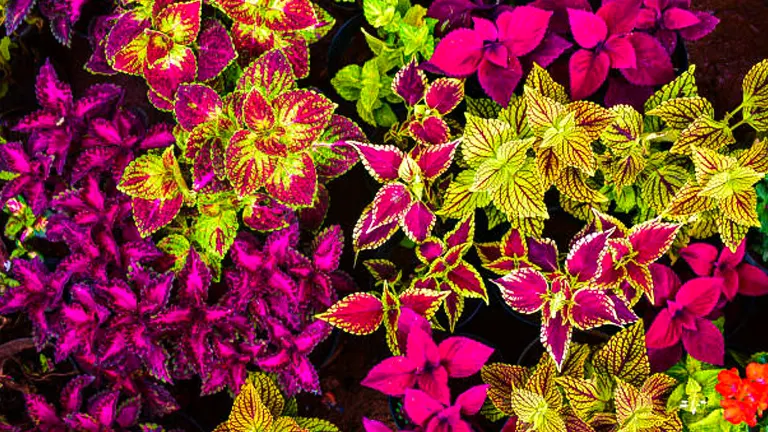
Whether you’re new to gardening or an experienced green thumb, our advice will cover everything from planting to ongoing care, helping you cultivate a stunning display of these colorful plants.
Table of Contents
- Understanding Coleus
- Planting Coleus
- Care and Maintenance
- Enhancing Plant Growth
- Troubleshooting Common Problems
- Advanced Growing Techniques
- Conclusion
- FAQs
Understanding Coleus
Varieties of Coleus
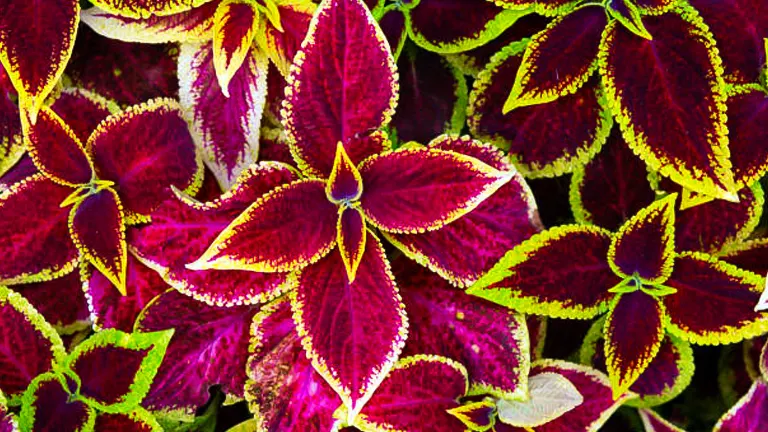
Coleus, scientifically known as Plectranthus scutellarioides, offers a stunning diversity in leaf coloration and form, making it a favorite among garden enthusiasts and botanists alike. Here are some standout varieties, along with their unique characteristics:
- ‘Wizard Series’: Known for its compact size (typically 12-14 inches tall) and exceptional shade tolerance, the Wizard Series is ideal for both container gardening and understory planting. Varieties within this series exhibit a range of colors from vibrant scarlet to deep maroon edged with lime green.
- ‘Kong Series’: Characterized by its large leaves, which can span over 6 inches, this series boasts dramatic color patterns, including mosaics of green, red, and cream. The Kong Series reaches a height of up to 18-22 inches, making it a striking choice for visual impact in a garden setting.
- ‘Fairway Series’: A dwarf variety that grows about 8-10 inches tall, known for its mosaic-like color patterns which include combinations of deep blues, vibrant pinks, and lush greens. This series is particularly robust against high humidity and intense heat.
Ideal Growing Conditions
Coleus thrives in a specific set of conditions that balance temperature, light, and moisture:
- Temperature: The optimal temperature range for Coleus is 60-75°F (15-24°C). Coleus can tolerate lower temperatures down to about 50°F (10°C) for short periods, but prolonged exposure to cold can result in leaf drop and stunted growth.
- Light: Coleus’s color vibrancy is directly linked to light exposure. The ideal lighting condition is bright, indirect light. Too much direct sunlight can bleach the leaves and lead to scorched spots, while insufficient light may cause the leaves to lose their bright colors and become more green.
- Soil and Moisture: Coleus prefers well-draining, rich soil with a slightly acidic to neutral pH (6.0 to 7.0). They require a consistently moist soil environment, but not waterlogged, as this can lead to root rot.
Scientific Insight and Comparative Table
For those interested in the finer details, the light intensity affects the pigmentation of Coleus leaves through a process known as photobleaching, where high light levels can degrade the chlorophyll and other pigments, reducing the leaf’s color saturation. Here is a table comparing the light tolerance and growth attributes of popular Coleus varieties:
| Variety Series | Height Range (inches) | Optimal Light Conditions | Unique Attributes |
|---|---|---|---|
| Wizard Series | 12-14 | Moderate to low light | Shade tolerant, compact form, ideal for understory |
| Kong Series | 18-22 | Moderate to bright indirect light | Large leaves, bold patterns, dramatic impact |
| Fairway Series | 8-10 | Bright indirect light | Heat and humidity resistant, vibrant mosaic patterns |
Planting Coleus
Optimal Planting Times
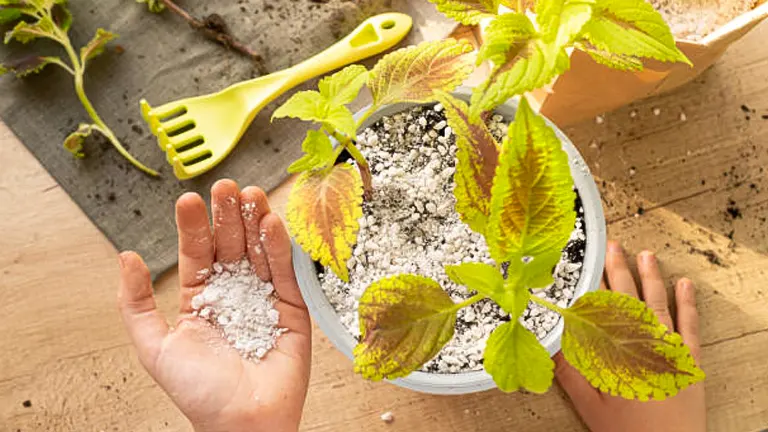
The timing for planting Coleus is pivotal to ensure healthy growth and development. In temperate regions, the ideal planting period is immediately after the last expected spring frost. This timing prevents cold damage as Coleus is highly sensitive to frost. For tropical climates where frost is not a concern, Coleus can be planted year-round, provided the heat is not excessive.
Soil and Fertilization Needs
Coleus flourishes in nutrient-rich, well-draining soil with a slightly acidic to neutral pH, ideally between 6.0 and 7.0. The plant’s growth response is notably influenced by soil quality, with loamy soil being the most conducive. Regular fertilization is crucial; a balanced NPK (Nitrogen, Phosphorus, Potassium) water-soluble fertilizer with a ratio of 10-10-10 or 20-20-20 should be applied bi-weekly. However, it’s important to avoid over-fertilization which can lead to lush but weak growth, with a possible reduction in the intensity of leaf coloration. To prevent this, conduct a soil test before application to adjust the fertilizer concentration accordingly.
Spacing for Growth
Proper spacing is essential for the optimal growth of Coleus, particularly in garden settings where competition for resources can impact plant health. Here are the recommended spacing guidelines based on planting density:
- Low Density: 15-18 inches apart, suitable for garden accents or when larger, more dramatic plants are desired.
- Medium Density: 10-14 inches apart, ideal for creating a fuller garden appearance without overcrowding.
- High Density: 6-8 inches apart, typically used in mass plantings for a bold color impact.
Scientific Insight and Comparative Table
Scientifically, the spacing affects not only the visual aesthetics but also the microclimate around each plant. Closer spacing can raise humidity levels around the plants’ microenvironment, which may increase the risk of fungal diseases. Here’s a table that outlines the effects of spacing on growth and health:
| Planting Density | Spacing (inches) | Light Exposure | Potential Growth Impact |
|---|---|---|---|
| Low Density | 15-18 | Ample | Maximizes individual plant growth and health, fewer disease issues |
| Medium Density | 10-14 | Moderate | Balances between growth and aesthetic density, minor risk of mildew |
| High Density | 6-8 | Limited | Intense color impact, higher disease risk due to reduced airflow |
Care and Maintenance
Watering Protocols
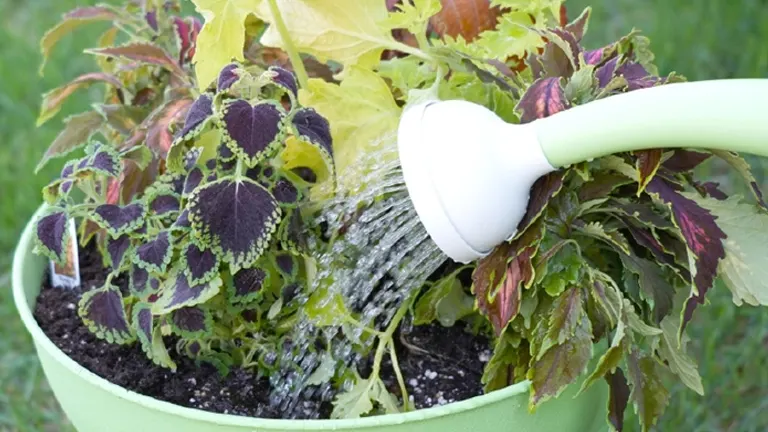
Proper hydration is crucial for maintaining the lushness and color vibrancy of Coleus. Here are key points to consider:
- Depth and Frequency: Water Coleus deeply enough so that water reaches the roots, encouraging them to grow downwards rather than staying superficial. This is particularly important during hot and dry periods. As a rule, water when the top inch of the soil is dry. The exact frequency will depend on climate, season, and soil type.
- Method: Direct the water at the soil level rather than over the leaves to prevent fungal diseases. Use a soaker hose or drip irrigation for the best results.
Pruning and Shaping
Effective pruning techniques not only shape the plant but also enhance its overall health and aesthetic appeal:
- Pinching: Pinch back the tips of Coleus every few weeks to encourage a bushier plant. This technique stimulates lateral growth, making the plant fuller.
- Deadheading: Removing flowers as they appear ensures that all energy is directed towards foliage growth, maintaining vibrant leaf colors.
Managing Pests and Diseases
Understanding the common threats to Coleus can lead to more effective pest and disease management:
- Common Pests: Spider mites and whiteflies are attracted to Coleus, particularly under dry and dusty conditions. Regular misting or spraying can deter these pests.
- Disease Prevention: Fungal diseases like powdery mildew thrive in moist, stagnant air. Promote good air circulation by spacing plants appropriately and using fans in indoor settings.
Scientific Insight and Comparative Table
Here is a deeper scientific analysis and a comparative table detailing how different watering and care practices affect Coleus:
| Care Aspect | Scientific Detail | Optimal Practice |
|---|---|---|
| Watering Frequency | Overwatering can cause root hypoxia, reducing nutrient uptake | Water when top inch of soil is dry |
| Pruning Frequency | Regular pruning increases cytokinin activity which promotes lateral growth | Pinch every 3-4 weeks during growth |
| Disease Management | High humidity increases transpiration and pathogen proliferation | Ensure good air circulation |
Enhancing Plant Growth
Light Management for Vibrant Colors
The intensity of leaf color in Coleus largely depends on light exposure. While the plant tolerates low light, bright but indirect light will enhance the richness of the leaf color. Avoid direct sunlight, which can bleach the leaves and lead to scorched spots. Experimenting with different lighting conditions can help you find the perfect balance that maximizes color intensity without harming the plant.
- Optimal Light Levels: Coleus plants require bright, indirect light to maintain their vivid colors. Light intensity between 10,000 to 20,000 lux is ideal. In low-light conditions, chlorophyll production increases, causing the leaves to turn greener and less vibrant.
- Light Spectrum: The quality of light also matters. Blue light (400-500 nm) promotes vegetative growth and enhances the intensity of leaf colors, while red light (600-700 nm) can help maintain the plant’s overall health.
- Avoiding Sunburn: Direct sunlight, especially during midday, can bleach the leaves and cause scorching. Scorched leaves often exhibit white or brown patches, indicating tissue damage.
Regular Fertilization Schedule
Fertilize Coleus with a balanced, water-soluble fertilizer every two weeks during the growing season. This will support robust growth and vibrant foliage. Be cautious of over-fertilization, which can lead to poor color and weak growth. During the winter months, reduce fertilization as the plant’s growth naturally slows.
- Fertilizer Composition: Use a balanced, water-soluble fertilizer with an NPK ratio of 10-10-10 or 20-20-20. Nitrogen promotes leaf growth, phosphorus supports root development, and potassium enhances overall plant health.
- Application Frequency: Fertilize every two weeks during the growing season. During the winter months, reduce the frequency to once a month or stop altogether, as the plant’s growth rate slows.
- Micronutrients: Ensure the fertilizer includes essential micronutrients such as iron, magnesium, and calcium, which are vital for photosynthesis and leaf coloration.
Seasonal Adjustments
Adjust your care routine seasonally to accommodate the changing needs of your Coleus. In spring and summer, focus on vigorous growth support with regular watering and fertilization. As autumn approaches, prepare the plant for winter by reducing watering and stopping fertilizer applications to allow the plant to rest.
- Spring and Summer: Focus on promoting vigorous growth by ensuring adequate water and regular fertilization. Monitor soil moisture levels closely, as higher temperatures increase evaporation rates.
- Autumn Preparation: Gradually reduce watering and fertilization as temperatures drop. This transition helps the plant acclimate to lower activity levels, preventing stress.
- Winter Care: For indoor Coleus, provide sufficient light using grow lights if natural light is insufficient. Maintain moderate watering, ensuring the soil remains moist but not waterlogged.
Scientific Insight and Comparative Table
Here is a detailed table providing scientific insights into the impact of various care practices on Coleus growth:
| Growth Factor | Scientific Detail | Optimal Practice |
|---|---|---|
| Light Intensity | 10,000-20,000 lux optimal for vibrant coloration | Bright, indirect light; avoid direct sun |
| Light Spectrum | Blue light (400-500 nm) enhances leaf color intensity | Use full-spectrum grow lights if needed |
| Fertilizer Composition | Balanced NPK (10-10-10 or 20-20-20) with micronutrients | Apply bi-weekly during growing season |
| Seasonal Watering | Adjust to reduce water stress; higher in summer, lower in winter | Gradual reduction in autumn, maintain moderate in winter |
Unique Information and Tips
- Use sheer curtains or shade cloth to diffuse intense sunlight, especially during peak hours, to protect Coleus from sunburn.
- Regularly test soil pH to keep it within the ideal range (6.0 to 7.0). Use lime to raise pH or sulfur to lower it as needed.
- Avoid temperatures below 50°F (10°C) to prevent cold stress. For indoor plants, maintain a consistent environment using space heaters or thermostats.
Troubleshooting Common Problems
Diagnosing Plant Issues
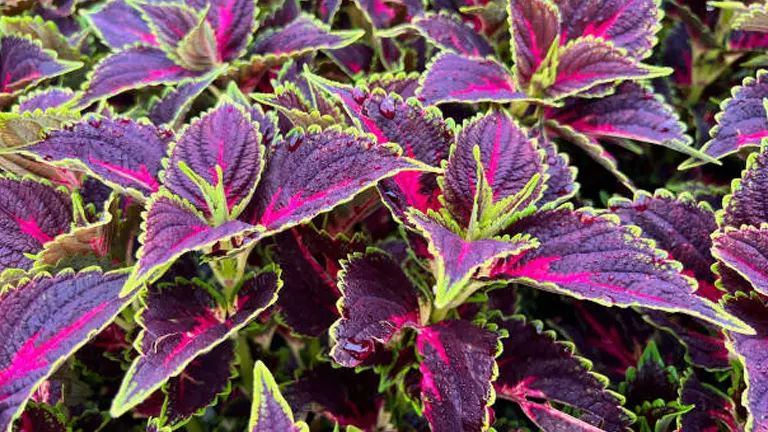
Recognizing early signs of distress in your Coleus can prevent minor issues from becoming major problems. Yellowing leaves may indicate overwatering or poor drainage, while drooping leaves often suggest underwatering or excessive heat. If you notice pale leaves with scorched tips, your Coleus might be getting too much direct sunlight.
Solutions to Common Problems
For overwatered Coleus, improve drainage by mixing perlite or sand into the soil and reduce your watering frequency. If underwatering is the issue, establish a more consistent watering schedule. For plants affected by direct sunlight, relocate them to a spot with filtered light or use a sheer curtain to diffuse intense sunlight. Regular application of insecticidal soap can address pest infestations without harming the plant.
Advanced Growing Techniques
Propagating Coleus
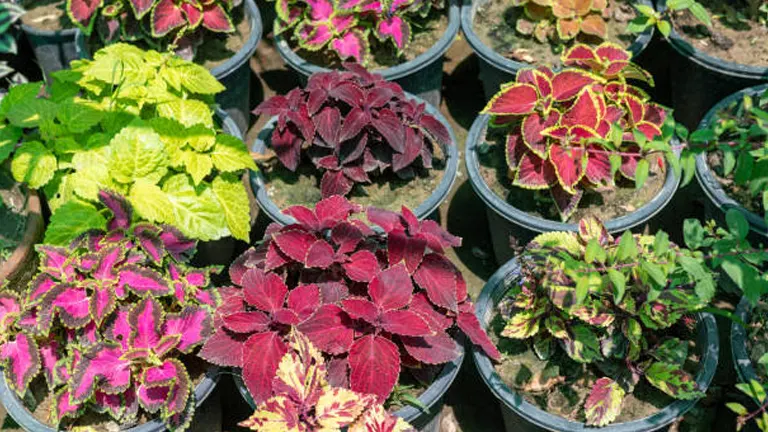
Coleus is easily propagated through stem cuttings, making it simple to expand your collection or share with others. Select a healthy stem, cut just below a leaf node, and remove the lower leaves. Place the cutting in water or directly into soil with rooting hormone. Roots typically develop within a few weeks, after which the new plant can be potted.
Landscape and Design Applications
Coleus is extremely versatile in landscape design due to its vivid foliage. Use it to create dramatic borders, fill in bare spots in garden beds, or add color to container gardens. Its adaptability also makes it ideal for themed gardens, such as tropical or Victorian styles, where its bright colors can be showcased against contrasting foliage or flowers.
Seasonal Care Tips
As temperatures drop in late autumn, consider moving outdoor Coleus indoors to protect them from cold. Provide ample light and reduce watering to match the slower winter growth rate. This adjustment helps prevent stress and prepares the plant for a healthy resurgence in the spring.
Related Post
- How to Fertilize Bougainvillea: A Complete Guide for Stunning Blooms
- How to Fertilize Apple Trees: Essential Tips for a Bountiful Harvest
- How to Fertilize Lemon Trees: Secrets for Thriving Citrus
- How to Fertilize Avocado Tree: A Step-by-Step Guide for Lush Growth
Conclusion
Growing and caring for Coleus is both a delightful and rewarding gardening endeavor. With its spectacular array of colors and patterns, Coleus can dramatically enhance any garden space or indoor area. By following the expert tips outlined in this guide—from planting and routine care to troubleshooting and advanced propagation techniques—you’ll be well-equipped to cultivate healthy, vibrant Coleus plants. Remember, the key to success with Coleus, as with many aspects of gardening, lies in attentive care and a willingness to adapt practices as you learn from the plant’s responses.
FAQs
- What is the best way to choose Coleus varieties for my garden?
When selecting Coleus varieties, consider the light conditions in your garden. Varieties with bright colors like red and yellow thrive in more light, while darker varieties are better suited for shade. Also, think about the size and growth habits that will fit best in your space. - Can Coleus be grown indoors, and if so, what care adjustments are needed?
Yes, Coleus can be grown indoors. Ensure they receive bright, indirect light and are away from drafts. Indoor Coleus may require less water than outdoor plants but be vigilant about humidity levels, as dry indoor air can weaken the plants. - How often should I fertilize my Coleus, and what type of fertilizer is best?
Fertilize Coleus every two weeks during the growing season with a balanced, water-soluble fertilizer. Reduce fertilization to once a month in the winter when plant growth naturally slows. - What are the signs that my Coleus is getting too much light?
Signs that your Coleus is exposed to excessive light include faded or bleached leaves and brown, crispy edges or tips. If you notice these symptoms, move your plant to an area with more shade or diffuse the light with a sheer curtain. - How do I propagate Coleus from cuttings?
To propagate Coleus from cuttings, cut a 4-6 inch stem just below a leaf node, remove the lower leaves, and either plant in moist soil or place in water. Roots should form within a couple of weeks, after which the cutting can be transplanted. - Is Coleus toxic to pets?
Coleus is considered non-toxic to dogs and cats, making it a safe choice for pet owners. However, it’s always best to prevent pets from chewing on plants as a general precaution. - How can I use Coleus in container gardens?
Coleus is excellent for container gardens due to its vivid foliage and fast growth. Use it as a ‘thriller’ or ‘filler’ in containers, combined with other plants that have similar light and water needs. Ensure your container has good drainage to prevent root rot. - What common pests affect Coleus, and how can I manage them?
Common pests include spider mites, aphids, and whiteflies. Manage these pests by inspecting plants regularly and using insecticidal soap or neem oil at the first sign of an infestation. Keeping the environment around your Coleus clean and avoiding wetting the leaves can also help prevent pest problems.
With these expert tips in hand, you’re well-equipped to cultivate your Coleus plants into a vibrant display of color and texture. Remember, every plant offers an opportunity to learn and grow as a gardener. Enjoy the journey and the stunning results of your care!

Kristine Moore
Forestry AuthorI'm Kristine Moore, a seasoned garden landscaping professional with over 30 years of experience. My extensive career has been dedicated to transforming outdoor spaces into stunning, sustainable landscapes. With a deep understanding of horticulture, design principles, and environmental stewardship, I have become a respected figure in the field, known for creating harmonious, visually appealing, and eco-friendly gardens. My commitment to excellence and continuous learning in landscaping trends and techniques has solidified my reputation as an expert in garden design and implementation.


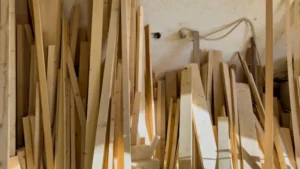





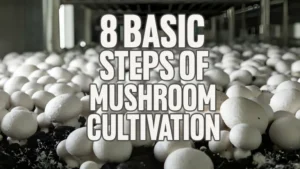




Thank you for your clearly written information about the Coleus . It has always been a favorite of mine. 😀
Pamela
July 19, 2024 2:45 pm